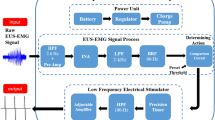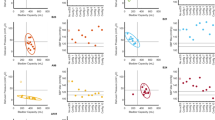Abstract
Objective
Traumatic brain injury (TBI) is a global scenario with high mortality and disability, which does not have an effectual and approved therapy till now. Bladder dysfunction is a major symptom after TBI, and this study deals with the alleviation of bladder function in TBI rats, with the aid of deep brain stimulations (DBS).
Methods
TBI was induced by weight drop model (WDM) and standardized with the experimental subjects with variable heights for weight dropping. The rats survived after TBI were considered for bladder dysfunction observations. DBS with variable stimulation parameters like cystometric analysis and MRI studies were also performed.
Results
After experimental studies, TBI 2-m-height crash was determined as suitable parameter due to minimal mortality rate and significant reduction in the voiding efficiency from 67 to 28%, whereas DBS significantly reversed the value of voiding efficiency to 65–84%. MRI studies revealed the severity of TBI impact and DBS localization.
Conclusion
The results showed profound therapeutic effect of PnO-DBS on voiding functions and bladder control on TBI rats.





Similar content being viewed by others
References
Finan DJ (2018) Biomechanical simulation of traumatic brain injury in the rat. Clin Biomech. https://doi.org/10.1016/j.clinbiomech.2018.01.015
Corrigan DJ, Selassie WA, Orman AJ (2010) The epidemiology of traumatic brain injury. J Head Trauma Rehabil 25:72–80. https://doi.org/10.1097/HTR.0b013e3181ccc8b4
Moody JB, Liberman C, Zvara P, Smith PP, Freeman K, Zvarova K (2014) Acute lower urinary tract dysfunction (LUTD) following traumatic brain injury (TBI) in rats. Neurourol Urodyn 33:1159–1164. https://doi.org/10.1002/nau.22470
Jiang HH, Kokiko-Cochran NO, Li K, Balog B, Lin CY, Damaser SM, Lin V, Cheng JY, Lee YS (2013) Bladder dysfunction changes from underactive to overactive after experimental traumatic brain injury. Exp Neurol 240:57–63. https://doi.org/10.1016/j.expneurol.2012.11.012
Miocinovic S, Lempka FS, Russo SG, Marks BC, Buston CR, Sakaie KE, Vitek JL, Mclntyre CC (2009) Experimental and theoretical characterization of the voltagedistribution generated by deep brain stimulation. Exp Neurol 216(1):166–176. https://doi.org/10.1016/j.expneurol.2008.11.024
Jen E, Lin WC, Hsieh HT, Chiu YC, Lu TC, Chen SC, Chen MC, Peng CW (2007) Prototype deep brain stimulation system with closed-loop control feedback for modulating bladder functions in traumatic brain injured animals. J Med Biol Eng 38(3):337–349. https://doi.org/10.1007/s40846-017-0326-1
Kringelbach ML, Jenkinson N, Green AL, Owen SLF, Hansen PC, Cornelissen PL, Holliday IE, Stein J, Aziz TZ (2007) Deep brain stimulation for chronic pain investigated with magnetoencephalography. Neuro Rep 18(3):223–228
Anderson RJ, Frye MA, Abulseoud OA, Lee KH, McGillivray JA, Berk M, Tye SJ (2012) Deep brain stimulation for treatment-resistant depression: efficacy, safety and mechanisms of action. Neurosci Biobehav Rev 36:1920–1933. https://doi.org/10.1016/j.neubiorev.2012.06.001
Salanova V (2018) Deep brain stimulation for epilepsy. Epilepsy Behav. https://doi.org/10.1016/j.yebeh.2018.06.041
Frederick C, Nucifora E, Woznica BJ, Lee N, Cascella A, Sawa (2018) Treatment resistant schizophrenia: clinical, biological, and therapeutic perspectives. Neuro Biol Dis. https://doi.org/10.1016/j.nbd.2018.08.016
Montgomery EB Jr, Baker KB (2000) Mechanisms of deep brain stimulation and future technical developments. Neurol Res 22(3):259–266. https://doi.org/10.1080/01616412.2000.11740668
Vitek JL (2002) Deep brain stimulation for Parkinson’s disease a critical re-evaluation of STN versus GPi DBS. Stereotact Funct Neurosurg 78:119–131. https://doi.org/10.1159/000068959
Wallace BA, Ashkan K, Heise CE, Foote KD, Torres N, Mitrofanis J, Benabid AL (2007) Survival of midbrain dopaminergic cells after lesion or deep brain stimulation of the subthalamic nucleus in MPTP-treated monkeys. Brain 130(8):2129–2145. https://doi.org/10.1093/brain/awm137
Veerakumar A, Berton O (2015) Cellular mechanisms of deep brain stimulation: activity-dependent focal circuit reprogramming? Curr Opin Behav Sci 1(4):48–55. https://doi.org/10.1016/j.cobeha.2015.02.004
Schiff ND, Giacino JT, Kalmar K, Victor JD (2007) Behavioural improvements with Thalamic stimulation after severe traumatic brain injury. Nature 448:600–603. https://doi.org/10.1038/nature06041
Cernak L (2005) Animal models of head trauma. NeuroRX 2(3):410–422. https://doi.org/10.1602/neurorx.2.3.410
Marmarou A, Foda MAAE, van den Brink W, Campbell J, Kits H, Demetriadou K (2010) A new model of diffuse brain injury in rats part I: pathophysiology and biomechanics. J NeuroSurg 112(2):291–300
Foda MAAE, Marmarou A (1994) A new model of diffuse brain injury in rats: part II: morphological characterization. J Neurosurg 80(2):301–313
Noto H, Roppolo J, Steers W, De Groat W (1989) Excitatory and inhibitory influences on bladder activity elicited by electrical stimulation in the pontine micturition center in the rat. Brain Res 492(1):99–115. https://doi.org/10.1016/0006-8993(89)90893-7
Goddeyne C, Nichols J, Wu C, Anderson T (2015) Repetitive mild traumatic brain injury induces ventriculomegaly and cortical thinning in juvenile rats. J Neurophysiol 113:3268–3280. https://doi.org/10.1152/jn.00970.2014
Hsieh TH, Kang JW, Lai JH, Huang YZ, Rotenberg A, Chen YK, Wang JY, Chan SY, Chen SC, Chiang YH, Peng CW (2017) Relationship of mechanical impact magnitude to neurologic dysfunction severity in a rat traumatic brain injury model. PLoS ONE 12(5):e0178186. https://doi.org/10.1371/journal.pone.0182300
Chen QJ, Zhang CC, Lu H, Wang W (2014) Assessment of traumatic brain injury degree in animal model. Asian Pac J Trop Med 7(12):991–995. https://doi.org/10.1016/S1995-7645(14)60174-7
Shohami E, Ginis I, Hallenbeck JM (1999) Dual role of tumor necrosis factor alpha in brain injury. Cytokine Growth Fact Rev 10(2):119–130. https://doi.org/10.1016/S1359-6101(99)00008-8
Denny-Brown DE, Russell RW (1941) Experimental concussion. Proc R Soc Med 34(11):691–692. https://doi.org/10.1152/physrev.1945.25.2.296
Lindgren S, Rinder L (1996) Experimental studies in head injury. Biophysik 3(2):174–180. https://doi.org/10.1007/BF01191611
Ommaya KA, Grennarelli AT (1974) Cerebral concussion and traumatic unconsciousness correlation of experimental and clinical observations on blunt head injuries. Brain 97(1):633–654. https://doi.org/10.1093/brain/97.1.633
Sullivan GH, Martinez J, Becker PD, Miller JD, Griffith R, Wist AO (1976) Fluid-percussion model of mechanical brain injury in the cat. J Neurosurg 45:520–534
Nilsson B, Ponten U, Voigt G (1977) Experimental head injury in the rat Part 1: mechanics, pathophysiology, and morphology in an impact acceleration trauma mode. J Neurosurg 47:241–251
Dixon EC, Lyet GB, Povlishock TJ, Findling RL, Hamm RJ, Marmarou A, Young HF, Hayes RL (1989) A fluid percussion model of experimental brain injury in the rat. J Neurosurg 67:110–119
Jang HJ, Kwon MJ, Cho KO (2018) Central regulation of micturition and its association with epilepsy. Int Neurourol J. https://doi.org/10.5213/inj.1836040.020
McMurray G, Casey HJ, Naylo MA (2006) Animal models in urological disease and sexual dysfunction. Brit J Pharmacol 147(S2):S62–S79. https://doi.org/10.1038/sj.bjp.0706630
Fry CH, Meng E, Young JS (2010) The physiological function of lower urinary tract smooth muscle. Auton Neurosci Basic Clin 154(1–2):3–13. https://doi.org/10.1016/j.autneu.2009.10.006
Andersson EK, Soler R, Füllhase C (2011) Rodent models for urodynamic investigation. Neurol Urodyn 30(5):636–646. https://doi.org/10.1002/nau.21108
Oostra K, Everaert K, Laere V, M (1995) Urinary incontinence in brain injury. Brain Inj 10(6):459–464. https://doi.org/10.1080/026990596124313
Khan Z, Hertanu J, Yang WC, Melman A, Leiter E (1981) Predictive correlation of urodynamic dysfunction and brain injury after cerebrovascular accident. J Urol 126(1):86–87. https://doi.org/10.1016/S0022-5347(17)54392-X
Khan Z, Starer P, Yang WC, Bhola A (1990) Analysis of voiding disorders in patients with cerebrovascular accidents. Urology 35(3):265–270. https://doi.org/10.1016/0090-4295(90)80048-R
Wyndaele JJ, Meyer MJ, Sy AY, Claessens H (1986) Intracavernous injection of vasoactive drugs, an alternative for treating impotence in spinal cord injury patients. Paraplegia 24:271–275. https://doi.org/10.1038/sc.1986.37
Blaivas GJ (1982) The neurophysiology of micturition: a clinical study of 550 patients. J Urol 127(5):958–963. https://doi.org/10.1016/S0022-5347(17)54147-6
Kadow TB, Tyagi P, Chermansky JC (2015) Neurogenic causes of detrusor underactivity. Cur Blad Dysfunct Rep 10(4):325–331. https://doi.org/10.1007/s11884-015-0331-6
Kelly EC (2004) Evaluation of voiding dysfunction and measurement of bladder volume. Rev Urol 6(Suppl 1):S32–S37
Krasmik D, Krebs J, Ophoven VA, Pannek J (2014) Urodynamic results, clinical efficacy, and complication rates of sacral intradural deafferentation and sacral anterior root stimulation in patients with neurogenic lower urinary tract dysfunction resulting from complete spinal cord injury. Neurourol Urodyn 33:1202–1206. https://doi.org/10.1002/nau.22486
Chew DJ, Zhu L, Delivopoulos E, Minev IR, Musick KM, Mosse CA, Craggs M, Donaldson N, Lacour SP, McMahon SB, Fawcett JW (2013) A microchannel neuroprosthesis for bladder control after spinal cord injury in rat. Sci Transl Med. https://doi.org/10.1126/scitranslmed.3007186
Benabid AL, Pollak P, Louveau A, Henry S, De Rougemont J (1987) Combined (thalamotomy and stimulation) stereotactic surgery of the VIM thalamic nucleus for Bilateral Parkinson disease. Appl Neurophysiol 50:344–346. https://doi.org/10.1159/000100803
Benabid AL, Pollak P, Gao D, Hoffmann D, Limousin P, Gay E, Payen I, Benazzouz A (1996) Chronic electrical stimulation of the ventralis intermedius nucleus of the thalamus as a treatment of movement disorders. J Neuro Surg 84:203–214
Chen CS, Grill MW, Fan JW, Kou YR, Lin YS, Lai CH, Peng CW (2011) Bilateral pudendal afferent stimulation improves bladder emptying in rats with urinary retention. Br J Urol 109(7):1051–1058. https://doi.org/10.1111/j.1464-410X.2011.10526.x
Klevmark B (2002) Volume threshold for micturition. Infuence of filling rate on sensory and motor bladder function. Scand J Urol Nephrol 210:6–10. https://doi.org/10.1080/003655902320765890
Kadow TB, Tyagi P, Chermansky JC (2015) Neurogenic causes of detrusor underactivity. Curr Blad Dysfunct Rep 10(4):325–331. https://doi.org/10.1007/s11884-015-0331-6
Seif C, Herzog J, Horst CV, Schrader B, Volkmann J, Deuschl G, Juenemann, Braun PM (2004) Effect of subthalamic deep brain stimulation on the function of the urinary bladder. Ann Neurol 55(1):118–120. https://doi.org/10.1002/ana.10806
Jen E, Heish HT, Lu CT, Chen CM, Lee FJ, Lin TC, Chen SC, Chu PY, Peng CW, Lin CW (2016) Effects of pulsed radio frequency neuro modulations on the rat with over reactive bladder. Neurol Urodynamic 36(7):1734–1741. https://doi.org/10.1002/nau.23183
Kruse NM, Noto H, Roppollo JR, Groat de W C (1990) Pontine control of the urinary bladder and external urethral sphincter in the rat. Brain Res 532(1–2):182–190. https://doi.org/10.1016/0006-8993(90)91758-9
Fan WJ, Li TY, Chen JJJ, Chen SC, Lin YS, Kou YR, Peng CW (2013) Sexually dimorphic urethral activity in response to pharmacological activation of 5-HT1A receptors in the rat. Am J Physiol Renal Physiol 305(9):F1332–F1134. https://doi.org/10.1152/ajprenal.00261.2013
Acknowledgements
The experimental procedures used in the present study were approved by the Institutional Animal Care and Use Committee (IACUC) of Taipei Medical University (TMU) and followed by the TMU IACUC guidelines to treat animals humanely and reduce animal suffering by use of appropriate anaesthesia and analgesics (IACUC Approval No. LAC-2013-0199).
Funding
This work was supported by the Taiwan Ministry of Science and Technology under the Grant Number MOST106-2221-E-038-010-MY3 and MOST107-2811-E-038-001 to C.W. Peng.
Author information
Authors and Affiliations
Corresponding author
Ethics declarations
Conflict of interest
The authors report no conflicts of interest.
Ethical approval
This work was approved and conducted under the ethical guidance of Institutional Animal Care and Use Committee (IACUC) of Taipei Medical University (Approval No. LAC-2013-0199).
Research involving human and animal participants
This article does not contain any studies with human participants performed by any of the authors.
Rights and permissions
About this article
Cite this article
Praveen Rajneesh, C., Lai, CH., Chen, SC. et al. Improved voiding function by deep brain stimulation in traumatic brain-injured animals with bladder dysfunctions. Int Urol Nephrol 51, 41–52 (2019). https://doi.org/10.1007/s11255-018-2028-1
Received:
Accepted:
Published:
Issue Date:
DOI: https://doi.org/10.1007/s11255-018-2028-1




